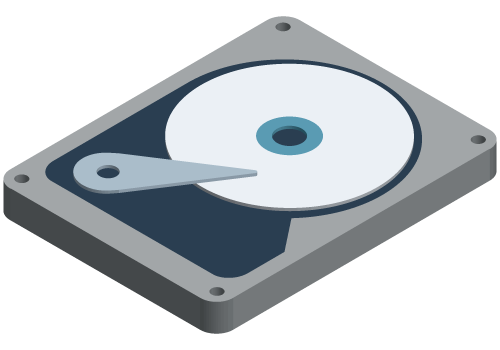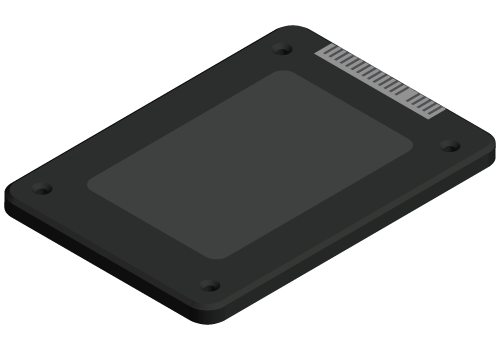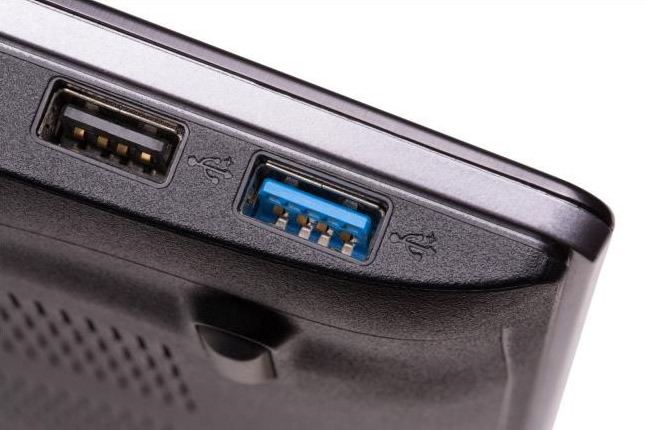
Complementing Your 3D Scanner
When buying a 3D scanner, there is a critical tool that often gets overlooked—the computer. However, if you don’t get one that is optimized to run the 3D scanning software, the control center to the entire 3D scanning operation, it can make or break your system.
3D scanning is a very data-intensive process. Consequently, it requires the right computer to complement the 3D scanner in order to get you the best results quickly. Often times, our customers already have computers and need to know if their systems are powerful enough to handle 3D data processing. If they are not, they would need to upgrade or purchase a completely new system for 3D scanning.
Understanding what kind of computer is appropriate for a 3D scanner can be challenging as there are so many options out there. If your system matches the specifications in this article, that’s great! You are all set to go. However, if not it may be time to consider getting a new one.


Generating high resolution, high accuracy 3D scans require a good computer to support the 3D scanner at its optimal performance. It also boosts productivity by running the 3D scanner at the best scan speed and performing tasks efficiently such as the post-processing of scan data.
Having a computer that doesn’t suit the 3D scanner can create performance issues. It can slow down the entire 3D scanning process. The computer may run slow and take upwards of 10 to 15 minutes to process a single scan. Other simple functions may be entirely inaccessible. The program may freeze or become unresponsive. The right system can entirely eliminate these issues for a fast and easy scanning process. A well-tuned optimized system can complete a single scan in 3 to 10 seconds!
The goal of this article is to give you a simple yet thorough explanation of the computer hardware requirements necessary for professional 3D scanners to perform at their best.
In our lab, we use professional systems including the HDI, Metron E, and Artec 3D scanners so we will use these 3D scanners to illustrate our points.

Operating System
The operating system plays a central role in how a computer functions and sorts information. It monitors computer hardware and software resources and provides common services for computer programs.
Depending on the 3D scanner, some can operate only on Windows operating systems while some can operate on either Windows or Mac operating platforms.
Using the suggested version(s) of the operating system(s) provided by the 3D scanner manufacturer would yield the best 3D scanning performance. They have done thorough testing to see which version(s) of the operating system(s) would be best to run the 3D scanning software.
For example, the HDI and Metron3D line of 3D scanners (HDI Advance, HDI Compact, and Metron E) only operate on Windows machines. This is due to the nature of the software, FlexScan3D, which requires Windows to capture, post-process, and evaluate scan data. Windows 10 is recommended as it is the most up-to-date version but Windows 7 and 8 will also work as the minimum requirements. Earlier than Windows 7 is not recommended due to outdated performance.
The handheld Artec 3D scanners can operate on Windows or Mac operating systems. Similar to HDI and Metron 3D scanners, Artec supports Window 7-10. For Mac, they support Mac 10.11 – 10.14 (El Capitan, Sierra, High Sierra, Mojave).

Processor
(CPU)
The processor or central processing unit (CPU) of a computer determines how quickly tasks can be completed. It receives data input, executes instructions, and processes information. It communicates with input/output (I/O) devices, which send and receive data to and from the CPU.
In order to keep scanning efficient, we recommend getting a quad-core Intel 2 GHz or better, something like an i7 or i9 would do very nicely. These systems are tried and true computer chips that have been known to effectively sort through data very quickly.

If you are looking to go portable (use a laptop or tablet for mobile 3D scanning) and want to save some money go with the i7.
It is also much more common for those who already have computers in the office, as it is good for daily use as office computers. It has multiple cores allowing for processing of multiple independent tasks at the same time.

If you prefer power and speed, the i9 would be a better choice.
It has more cores and the ability for hyperthreading, which is like adding more cores digitally, allowing for even more tasks to be completed quickly. In terms of 3D scanning, this greatly impacts how fast the 3D scanning software can complete its algorithms.

RAM
(Memory or Random Access Memory)
RAM can be considered as short-term memory for a computer. It temporarily stores data and acts as the computer’s working memory. Programs that are currently running as well as open files are stored in RAM.
RAM can be a limiting factor when it comes to output speed. To compare it to a processor let’s imagine a river. The speed of the water is determined by your CPU and the width of the riverbank is controlled by the RAM. You could have a fast river but if it is narrow then you aren’t getting the most amount of water possible. You could have a wide river but if it is slow then it is not much better.
Combining a good CPU with lots of RAM can make a significant difference in the performance of your machine.
For the portable and economic systems we recommend 16 GB or 32 GB. 32 GB is more expensive but worth the investment. For the supercomputer 3D scanning station, 32 GB or 64 GB would be better. 64 GB is going to allow very quick processing time and will greatly reduce the amount of time you have to spend time 3D scanning.

Storage
(Hard Drive)
It’s the place where data gets stored even when the computer isn’t being used and is turned off. It’s considered as the computer’s long-term memory.
Storage, or hard drive, is important for holding your files. Just like an iTunes library full of songs, it only takes a few months of 3D scanning before you have a library full of scans. Unlike songs, 3D scan files are very large, some scans can be up to a few gigabytes a piece. A computer could fill up quickly if it doesn’t have enough room to store all the information.
In the modern age, we recommend up to 1 TB of storage. It is relatively cheap and gives you the peace of mind that there is enough space to house a year or two of scan data.
A solid-state drive (SSD) will go faster and improve the time it takes to turn on the machine and get going. Mechanical drives still work perfectly well and are less expensive but they are slower and do take up more space.
The main difference between SSD drive and mechanical drive is that for SSD, information is stored in microchips so it has no moving parts. On the other hand, a hard disk drive uses a mechanical arm with a read/write head which moves around and read information. This difference makes the SSD perform at a much faster rate.

If you are doing a lot of scanning and want to keep all your information, we highly recommend getting some external hard drives and transferring the scan data to the drives in order to save space on the computer.
If you already have a computer and are not purchasing a new one, make sure you have at least 250-500 GB of free space on your hard drive.

Graphics Card
(Video Card or GPU)
It determines how the computer displays graphical data in terms of clarity, color, definition, and overall visual appearance.
A good graphics card is critical for 3D scanning. This is because the computer needs to translate all of the scan information into three-dimensional graphical information and display it on the monitor. Most of the 3D scanners we offer can take a single scan with millions of 3D measurement points. Getting that information to display correctly is no small task and requires some heavy lifting.
Thankfully the video game industry has helped this tremendously and we recommend getting graphics cards that were originally designed for video gamers.
Nvidia is an excellent company that makes exactly what the 3D scanning industry needs. The Nvidia GeForce 1070 up to the GeForce 1080 Ti (high-end) are excellent models that perform consistently well. If you want a more affordable graphics card, Nvidia GeForce 1050 or 1060 (mid-range) are also good choices.
Recently Nvidia released a 2000 series that performs even better, but at a higher price. It can effectively double your speed especially for those users who are doing quality inspection or reverse engineering. If your computer has an integrated graphics card that is made by another company it needs to be at least 2 GB in size.

Ports
Connectors for the computer to communicate with external devices and work with them.
There are some ports essential for connecting a 3D scanner to the computer in order for them to interface with each other. You need to make sure the computer has all the necessary ports you need to connect the 3D scanner and any ancillary devices.
For example, a 10/100/1000 ethernet connection is needed for the HDI Compact C series of 3D scanners. This is going to be your old school hard wired internet connection. If you get Internet only by that port it might be a good idea to get Ethernet to USB conversion cable. This will allow the computer to get Internet through the standard Ethernet connection.
For HDI Advance and Metron E series 3D scanners, the computer is going to need an HDMI port (if you are using a desktop system it may need two as one is needed for the monitor) and 2 USB 3.0 ports. The USB 3.0 is very important as the cameras need a certain speed in order to operate correctly.

USB 2.0 (left) and USB 3.0 (right). Photo source: How-to Geek
You know if your system has it if there is a 3.0 symbol above the port or the inside is blue. An additional USB port is needed for 3D scanning accessories such as a rotary table system and another for USB license dongle.
If a computer does not have enough USB ports, a powered USB 3.0 hub is very cheap and can accommodate all the required cables.
Final Thoughts
Figuring out the best 3D scanner for a project or process can be tricky. Selecting a computer to complement the 3D scanner doesn’t have to be.
To summarize, the table below lists the technical specifications of:
- a portable (i.e. laptop) and/or economical computer system
- a stationary computer powerhouse
| Affordable Computer Laptop (Portable) | Performance Computer Desktop (Stationary) | |
|---|---|---|
| Operating System |
Windows (7-10)
Mac OS 10.11-.10.14 (applies to Artec 3D scanners only) |
Windows 10
Mac OS 10.14 (applies to Artec 3D scanners only) |
| Processor (CPU) | Intel i7 | Intel i9 |
| Memory (RAM) | 16-32 GB | 32-64 GB |
| Storage (External Drives Recommended) | 1 TB | 1 TB |
| Graphics Card | Nvidia GeForce 1050 – 1060 | Nvidia GeForce 1060 – 1080 Ti or Nvidia GeForce 2000 Series |
| Ports |
HDI Advance or Metron E 3D Scanners:
|
|
You should always check with your 3D scanner vendor and they will be able to give you the right technical specification document for your 3D scanner. It serves as a guideline in determining if your computer is good for 3D scanning.
Computer Technical Specifications Documents
-

HDI 3D Scanners
-

Metron E 3D Scanners
-

Artec 3D Scanners
Still unsure if your existing computer is powerful enough for 3D scanning or if you need to upgrade or purchase a new computer system?
If you already have a computer and you are not sure if your existing computer is powerful enough for 3D scanning, it’s best to contact your 3D scanner vendor and they should be able to help.
This would depend on a variety of variables such as:
- If you need a portable system for travelling or all of the scanning is done in the office or lab
- Speed, performance, or budget is most important to you
- Your use case
If you purchase a 3D scanner from us, feel free to contact us. We can help you quickly determine the best computer solution for your scanning system. Or, we can also recommend custom solutions and setups for your specific use case and scanning requirements.
A 3D scanner expands the capabilities of a 3D printer, allowing you to replicate the shape of almost any object. Together, the two technologies create a powerful, digital workflow that can simplify and sophisticate processes in a range of industries.